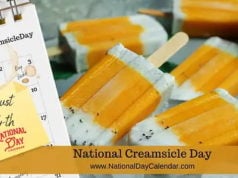
National Clean Out Your Refrigerator Day on November 15 encourages us to prepare for the upcoming holidays. Get together a soap and hot water filled bucket, disinfectant, a sponge and a garbage bag. Then you will be ready for the day!
- Sanitation Foundation (NSF) International found that the meat and vegetable drawers were the dirtiest spots in our kitchens – well with regards to causing disease.
- The first household refrigerator produced by General Electric in 1911 was based on a design by a French Cistercian monk and physics teacher named Marcel Audiffren. The monk’s sulfur dioxide refrigerating process took the form of a wooden refrigerator named the Audiffren. It cost $1000, which was twice as much as an automobile.
- Salt water, commonly known as brine, is sometimes used as a food preservative and refrigerant. Medieval peoples discovered that brine absorbs heat as it evaporates, and placed containers in brine to keep them cool. In America, meatpacking got its name in the 18th century because workers packed meat into brine barrels.
- Albert Einstein is the co-inventor of a refrigerator. He and his former student Leo Szilard received a patent for it in 1930. Coolants used at the time could be toxic, and Einstein got the idea for a simple, single-pressure absorption refrigerator when he read about a sleeping family killed by leaking refrigerator coolant.
- A crisper is a refrigerator drawer or compartment used to keep vegetables and fruit fresh and “crisp” (thus the name). Crispers work by maintaining humidity levels suitable for fresh vegetables and fruit.
- Louise J. Greenfarb of Henderson, Nevada, has over 32,000 different refrigerator magnets. She is appropriately known as “The Magnet Lady.”
- Over 8 million refrigerators are sold each year in the U.S. About 70% of them are top mount, i.e. freezer on top and fridge on bottom. One-quarter are side-by-side refrigerators, which use more energy than top mount models. Less than 5% are bottom mount refrigerators in which the freezer is located below the fridge.
- About 23% of American households contain two refrigerators.
- In 2004, Olaf Diegel, a diabetic, invented a pocket-sized refrigerator for carrying insulin on trips.
- In 2007, Duke University engineering graduate John Cornwell invented a mini fridge with a remote-controlled beer can extractor and catapult.
- Refrigerator spends around 10% of total electricity in a common household.
- Refrigerator is more efficient if it has more items in it.
- The history of artificial refrigeration began with a Scottish professor William Cullen who designed a small refrigerating machine in 1755.
Sources:












